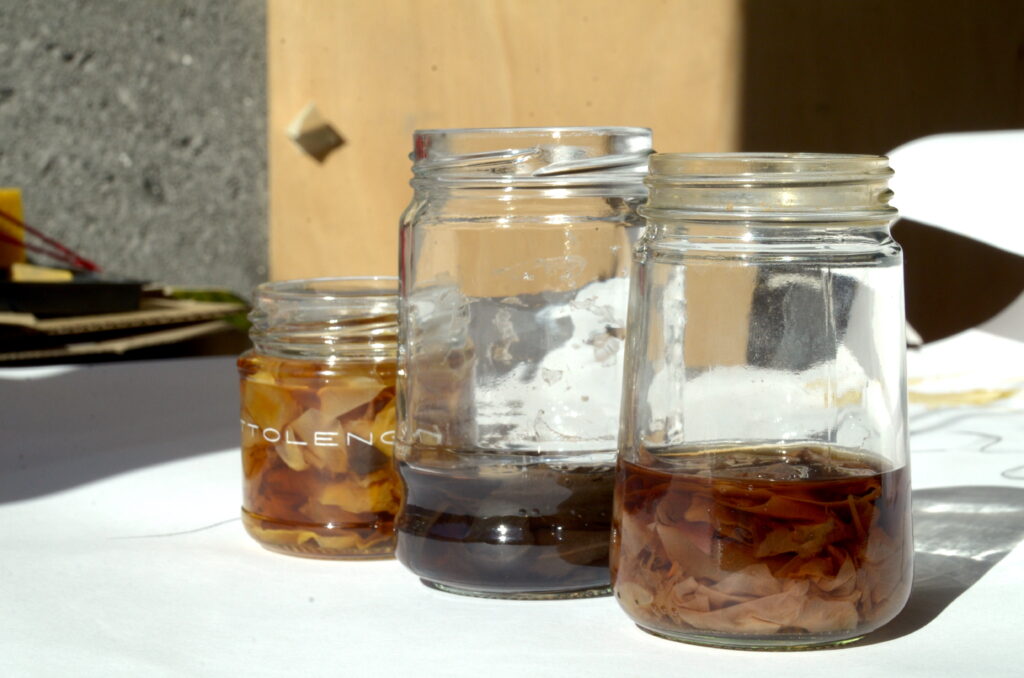
Making inks was at the core of the film that we co-created with parents who had experienced the loss of one twin from a multiple pregnancy. Workshop sessions were structured around the three stages of the ink-making process, as outlined by Jason Logan in Make Ink: (1) find ink (gathering the materials); (2) make ink (creating and bottling the inks); and (3) test ink (drawing and writing with the inks). The natural materials collected either on the walks or in other meaningful places – bilberries, buttercups, rose petals, an empty crab shell – were distilled into inks, which were in turn transformed into drawings and film animations. The memories of the lost babies permeated these activities, and ink making became its own ritual of commemoration.
The parents spoke often during the making of the film about the bottling up or repression of a grief that could not easily be articulated, because it is not well understood. Outside the family, the loss often went unspoken and even within the family it was hard to share, particularly across the generations. The inks gave a new and different resonance to what it meant to bottle up feelings associated with the loss. One parent observed: ‘having those gorgeous little bottles – bottled up feelings and emotions and places – it’s a really nice thing to have at the end of the project. The bottles are sitting on the shelf so we know that any time we want to we can go back and use those again and we know that if we see other things that we like we can make more inks. Even for anniversaries or things like that we know we can do that.’ The ‘bottling up’ of the feelings and places associated with the walks as inks created new memories, and grief was experienced not as internal, but as an object on the shelf that could be picked up and put down, used and remade.
The parents talked about the beneficial process of gathering materials on the walks, which gave dedicated time as a family to remember, and provided them with an activity on which to focus: ‘I think as an actual process, it’s a wonderful therapy tool – I’m not sure if that’s the right phrase – just to be able to spend some time somewhere that you like thinking about the loss and then having something practical to do. We are going somewhere that we enjoy being and we want to collect these materials and we are going to turn them into something completely different. It might have started out as buttercups or crab shells, but it ends up being this beautiful film.’ The transformation of the materials into something different – and something beautiful – is key to the project’s meaning for the parents.
Kate made inks in her studio from the materials gathered on the walks, and she also gave kits and instructions to the parents so that they could make their own inks, either between sessions or once the sessions had ended. One parent commented of this aspect of the project: ‘It was easy to make the inks and we did our own from the instructions and equipment that Kate gave us. I think this was something that could be given to all sorts of families and not just families that have lost a child but anybody who has lost anyone.’ While the families appreciated the creativity of what could be done with the inks – the drawing and writing that they enabled – the ink making itself seemed to be particularly helpful for navigating grief as a family, and the bottled ink was treasured in and of itself.
Babs Behan, founder of Botanical Inks, has written of ink making from natural materials:
There is something simple and beautiful about walking out onto the land and picking up fallen leaves, harvesting flowers and berries, and digging up muddy roots and then soaking them in water to extract their colour. I have seen people falling in love over and over again with these old-new ways of creating something – they love the fact that bringing more beauty into the world needn’t be harmful to the environment or to their own personal health. (p. 10)
In the context of our project, making inks transformed the bottling up of feelings about a difficult form of grief into a positive meaning and activity, and provided beautiful objects that the parents could keep once the project had finished. Like Behan, we also watched the parents fall in love with the techniques and processes of ink making that Kate introduced to them in the workshop sessions.
References
Babs Behan, Botanical Inks: Plant-to-Print Dyes, Techniques and Projects (London: Quadrille, 2018).
Jason Logan, Make Ink: A Forager’s Guide to Natural Inkmaking (New York: Abrams, 2018).
